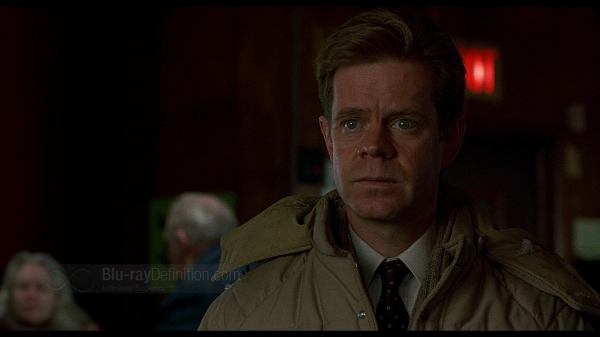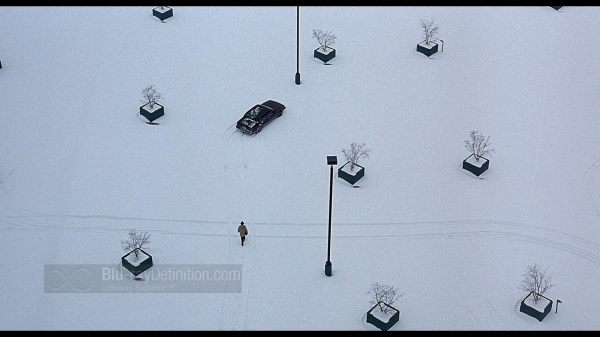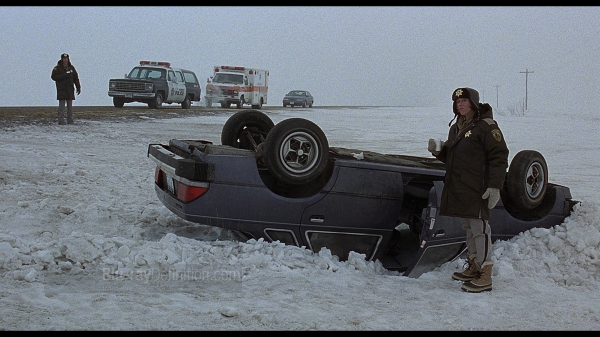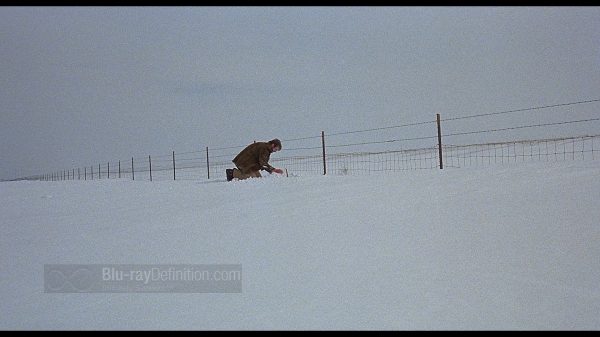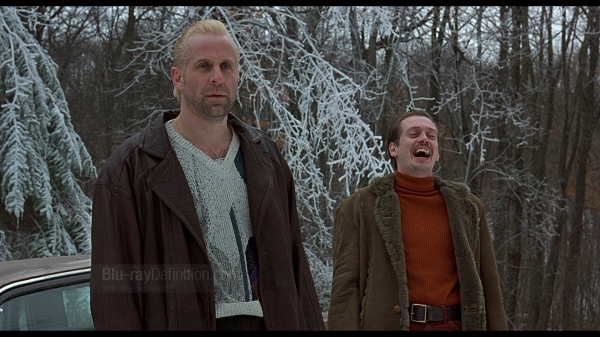– –
More screen captures (19 total)
The Film
[Rating:5/5]
In 1996 not many could have guessed that the Coen brothers could have made such a quietly understated yet intriguingly dark film with subtle direction and beautifully reserved cinematography by Roger Deakins. With the critically acclaimed, but in-your-face films such as Barton Fink and Raising Arizona in their resumé, Fargo came as a welcome and pleasant surprise that helped catapult the brothers from cult status straight into the mainstream.
Returning to tales of their native Minnesota to craft a dark comedy that walked a thin line between fact and fiction, Joel and Ethan Coen probed the depths of the human psyche in this often psychotic, yet strangely amusing tale of the foibles of rural and suburban upper Midwestern life. Going down as easy as the pretensions of “Minnesota nice,” as cold-blooded and cold-hearted as an ex-girlfriend from St. Paul, Fargo draws you in with its lilting locally inflected dialogue.
Bumbling car salesman, Jerry Lundegaard (William H. Macy), in debt up to his ears from embezzling hundreds of thousands of dollars, hires two thugs (Steve Buscemi and Peter Stormare) to kidnap his wife, Jean (Kristin Rudrüd) so he can get the ransom money out of his shrewd, but rich, father-in-law Wade (Harve Presnell). Unfortunately for Jerry, the inept kidnappers quickly make a hash of things and turn the situation into a triple homicide involving a Minnesota State Trooper before a ransom is ever made.
Halfway into the film we get our first glimpse of the seven-months-pregnant Fargo Police Chief Marge Gunderson (Frances McDormand), who’s drawn into the investigation of the triple homicide of the Minnesota State Trooper and two other passersby. Marge and her husband Norm (John Carroll Lynch) are the prototypical hayseed Midwestern family, right down to Marge’s flip hairdo and Norm’s cardboard box personality and profession as a duck painter competing to get his designs on postage stamps — you can’t get much more corn fed than these folks. But, Marge’s innocence and unflappable politeness even in the face of gruesome killings and recalcitrant suspects helps her stumble into good police work, and she begins to unfold the mystery behind the Sate Trooper’s death and close in on Jerry Lundergaard in the process.
Although titled Fargo, after the North Dakota town where the first scene of the film takes place as Jerry meets with the kidnappers, the film actually takes place mostly in Minnesota — in Brainerd and Minneapolis; none of the scenes were filmed in North Dakota. What really makes the film, however, is its authenticity. Never mind the actuality that most metro-area Minnesotans don’t speak with that deep, Scandinavian-inflected deadpan that the Coen’s scripted down to every last “Yah” and “You Betchya,” but it fits and the acting by the two leads, William H. Macy and Frances McDormand, is so natural that there is no sense they are milking the dialect for effect. They make viewers feel at home with these characters — the ineptitude of the man-child Jerry and the homespun sincerity of Marge open us up for acceptance to the sometimes off-kilter events and wildly violent incidents that could only take place in “Stepfordian” worlds such as this.
Through it all, Roger Deakins’ gritty, and geometric cinematography helps make Minnesota itself a looming character in this uneasy fable of fables as he turns his lens on the great white north lands and turns the shade white into a brilliantly stark palette.
Fargo was, at the time, Joel and Ethan Coen’s cinematic triumph and, arguably, they have yet to trump it. It will forever have a place alongside the classics of cinema as one of the most haunting, amusing, and memorable pieces to come along in the 20th century.
Video Quality
[Rating:4/5]
From the beginning Fargo has been praised for its marvelous cinematography by Roger A. Deakins and this Blu-ray release perfectly captures the look of the film in its original 1.85:1 aspect ratio in an AVC/MPEG-4 encoding that is free from any noticeable compression artifacts. Viewers unfamiliar with Fargo should be warned, however, that it is a purposely-grainy film with a muted color palette. As such, do not expect a pristine, crystal clear “Discovery Channel” look from this release. What is presented here, however, is something splendidly film-like, sharp, and organic. There are no obvious signs of Digital Noise Reduction (DNR) that have been applied, and there are some occasional speckles of dust and scratches that are easily overlooked. Black levels are stable with good shadow details, contrast is good with no clipping or blooming and overall detail is solid, in everything from clothing to faces. This is a prime example of how a catalogue release should be brought to Blu-ray.
Audio Quality
[Rating:3/5]
Being very much a quiet, dialogue-driven film, Fargo’s soundtrack is not going to wow anyone and it most likely will not become a demonstration disc to show off anyone’s sound system anytime soon. There is an English DTS-HD Master Audio 5.1 (48Khz/24-bit) soundtrack provided and action is mainly mixed across the front three channels with some very light ambience reserved for the surround channels and very little in the way of low frequencies. Although dialogue is always intelligible, there is some noticeable clipping in dialogue throughout the film. Overall, it’s a dry sounding, stagnant mix that is not very engaging, but it serves the film well enough.
There are also English Dolby Surround, Castilian Spanish DTS 5.1, Brazilian Portuguese Dolby Digital 5.1, French (Parisian) DTS 5.1, French (Quebecois) Dolby Digital 5.1, German DTS 5.1, Italian DTS 5.1, and Latin Spanish DTS 5.1 options available.
Supplemental Materials
[Rating:3/5]
The supplements provided on the release of Fargo are hardly abundant, but what is made available is interesting and informative, even of there are no high definition video extras provided.
The supplements available on this release are:
- Commentary with Director of Photography Roger A. Deakins
- Minnesota Nice Documentary (1.33:1; 480i/60) — This “making of” featurette gives a detailed account of the development of the film and the Coen’s, native Minnesotans, connection to the area.
- Trivia Track — This in-movie pop-up trivia track will display factoids on everything from trivia about the MGM Lion logo to the history of the founding of Fargo, North Dakota. It seems to be all over the place and isn’t always completely relevant to the film itself, but a lot of the information is interesting, nevertheless.
- Photo Gallery — Production stills
- Theatrical Trailer (1.78:1; 1080p/24)
- TV Spot (1.33:1; 480i/60)
- American Cinematographer Article — This a reprinting of an American Cinematographer Article about the Coen brothers and cinematographer Roger A. Deakins, with some nice production stills interspersed.
The Definitive Word
Overall:
[Rating:4/5]
Fargo is one of the classic films of modern cinema. Its darkly comedic examination of the seething undercurrent of violence suppressed in outwardly polite societies combined with its beautifully simple cinematography make it a worthy candidate for film school curriculum and film enthusiasts’ collections everywhere. Thankfully, MGM has done this release justice, with a proper transfer that preserves its aesthetic on Blu-ray Disc and it is easy for me to recommend wholeheartedly.
[amazon-product]B001U6YI8I[/amazon-product]




